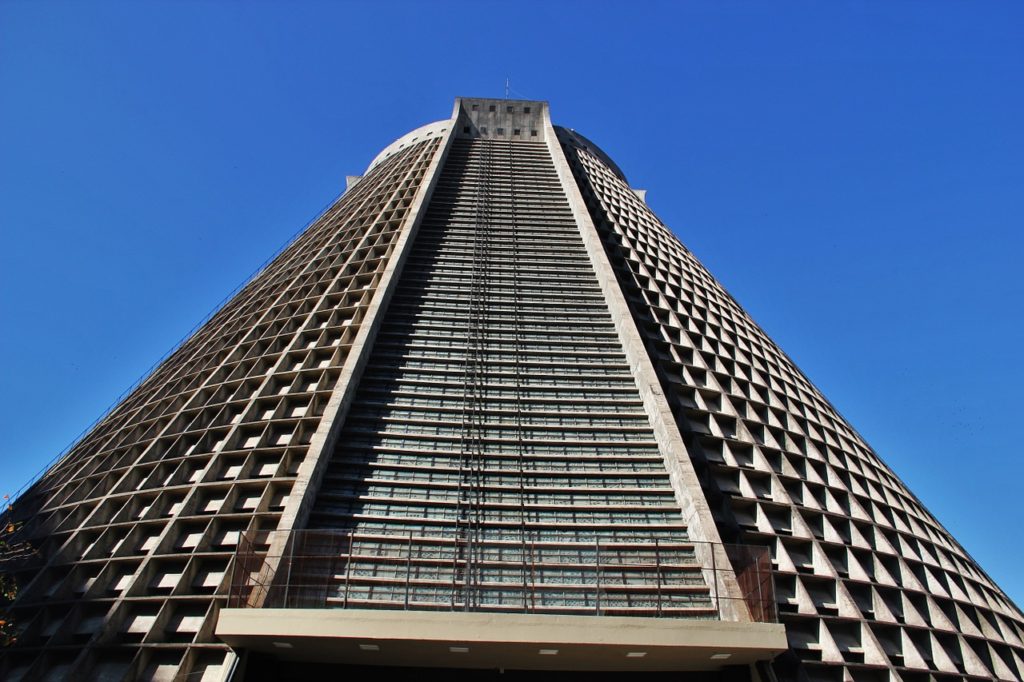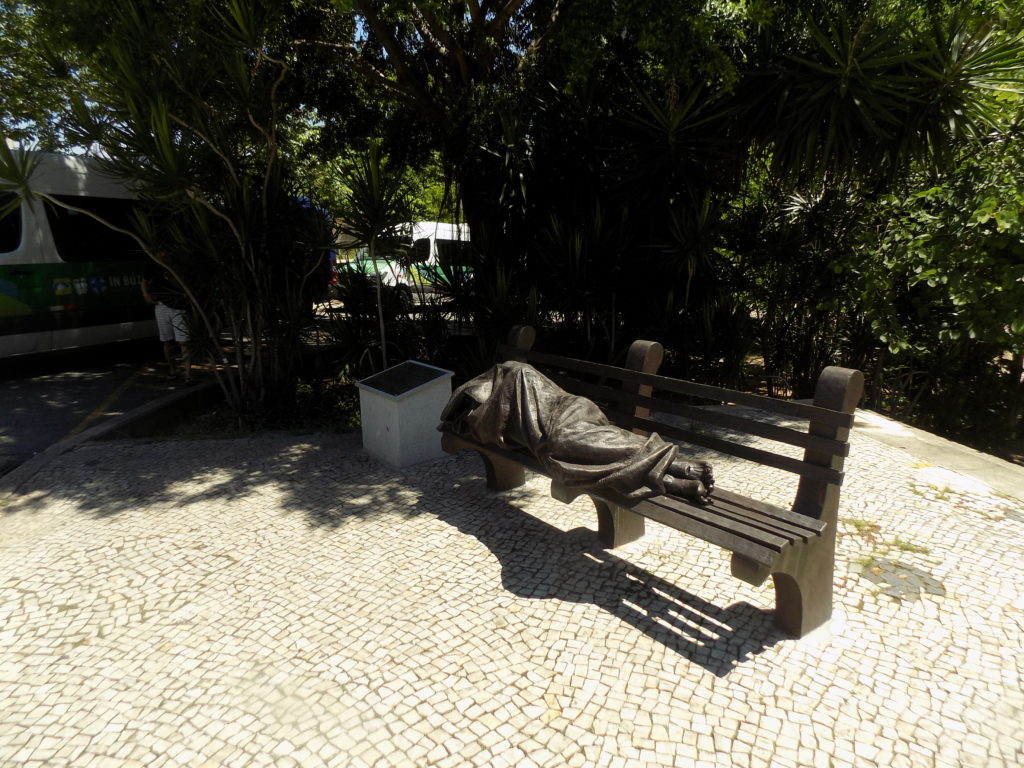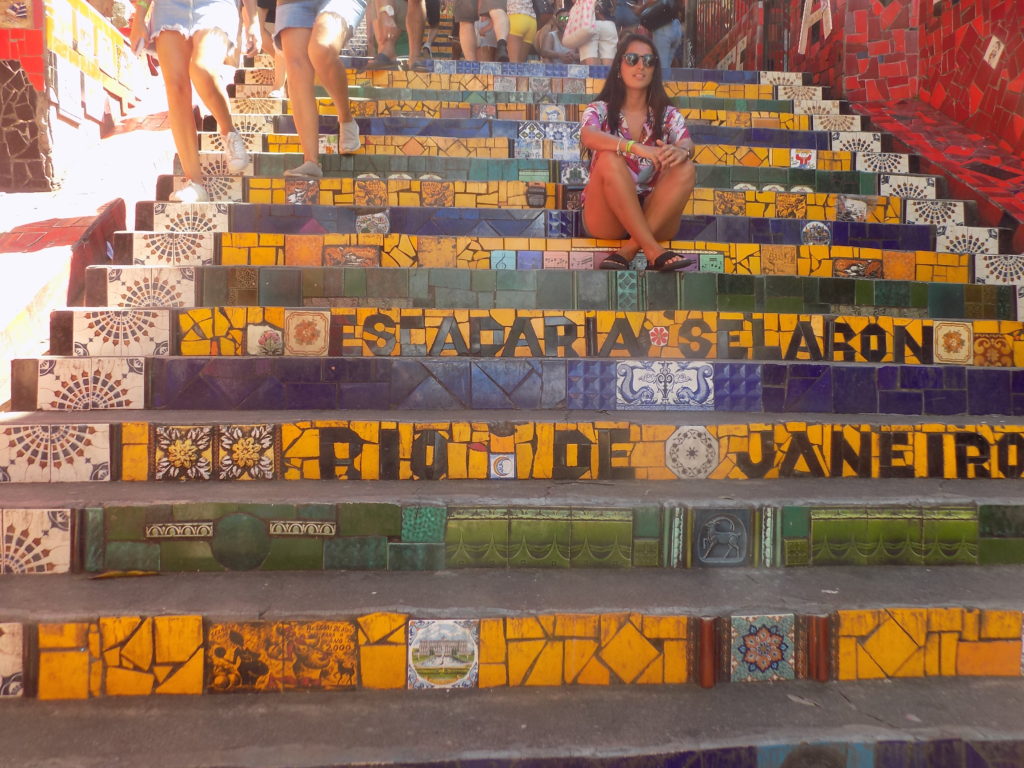Two types of Cathedral
Having finished our foray to the east, we turned around and motored west then north toward the old city center. Along the way we passed the Lagoa Rodrigo de Freitas (Rodrigo de Freitas Lagoon) which was the site of the 14 rowing competitions in the 2016 Summer Olympic Games. While people still row on the lagoon and jog or cycle around it, no one swims in it because of the high levels of pollution. Recently, native mangroves have been reintroduced but the pollutants remain and frequent algae blooms choke off the oxygen supply and fish generally don’t survive.
We didn’t leave the van as we passed the lagoon but we would make a brief sortie at our next stop which is certainly, for Brazilians of almost any belief system, a temple of sorts and a place that generates a rather secular form of worship. The stop was in front of the Estádio Jornalista Mário Filho more commonly known as Estádio Maracanã (Maracana Stadium).
The cornerstone was laid in 1948 and the stadium opened in 1950 when Brazil hosted soccer’s World Cup for the first time. The official name of the stadium honors a a journalist from the state of Pernambuca who championed its construction. The colloquial name is attributed to the Maracanã River that flows through Rio’s North Zone and empties into Guanabara Bay. The river’s name derives from a Tupi-Guarani word for a type of parrot that is native to the region.
After dodging the street hawkers selling bottled water, cheap souvenirs, or offering to take a photo (for a few reals, of course) with an ersatz World Cup we hopped back into the van and rumbled past the now sadly deserted Sambadrome on our way to the Catedral Metropolitana de São Sebastião or Metropolitan Cathedral of Rio de Janeiro. This towering structure – an alternative spot to worship for Brazilians of a different stripe – was,
oddly I thought, inspired by Mayan pyramids. (I found it odd because although the origins of Maya culture long predate the Inka, their empire reached only as far south as current day Honduras and little evidence, if any, exists linking the Maya with South America let alone Brazil.) Designed by Edgar Fonseca, construction of the cathedral, which can hold up to 20,000 people, began in the 1960s and required more than a decade to complete. (Thinking of the centuries required to build some of the grand cathedrals of Europe, a bit more than a decade is a veritable blink of an eye.) Stained glass windows invisible from the outside ascend 61 meters up each wall where they connect to a cross shaped skylight.
The bell tower and this sculpture of a figure wrapped in a blanket
are in the plaza outside the cathedral. With a little research after I returned home, I learned that the sculpture was created by Timothy Schmalz – a Canadian artist who donated it to the Archdiocese of Rio. It’s called “Homeless Jesus” and is intended to illustrate the ever-widening wealth gap and to “look at those who live on the streets of our city as brothers and sisters”.
A bit more of Old Rio
A few aspects of Rio became evident as we continued our drive through the old city center. First, we were fortunate that we were riding through this section during Carnaval week because many of the businesses in this largely commercial district were closed and this minimized traffic congestion. Second, the imperfections I mentioned in the initial post – mainly in the form of scarred and seemingly unloved buildings – surfaced with mildly disheartening regularity.
We exited the van again for a brief walk along the water at the outer edge of Guanabara Bay passing the Old Cathedral, the site of the Olympic flame, and the Museum of Tomorrow and had a look along the bridge that crosses the bay into the bedroom community (a new American phrase for our guide Etienne) of Niterói.
Escadaria Selarón
Whether it’s in building them, climbing them, or simply admiring them it seems that people around the world (myself included) have a fascination with great staircases. Some maximize the natural setting such as the Tianmen Mountain stairs in Hunan or the San Juan de Gaztelugatxe in Spain. Others such as the 70-degree incline of the stairs at Angkor Wat in Cambodia or the 686 steps to the Santuario de Nossa Senhora do Remédios in Portugal maximize the effort needed for their ascent. Still others utilize urban settings and challenges. Think of Rome’s Spanish Steps, the Potemkin Steps in Odessa or the Rue Foyatier as a means of climbing Montmartre to reach Sacre Coeur.
Rio being Rio, has its own approach to staircase drama – the Escaderia Selarón. Jorge Selarón was born in Chile in 1947 and spent much of his life wandering the world and earning his living as a painter. One biography says that before settling in Rio he sold more than 25,000 paintings and resided in more than 50 countries. In 1983, the peripatetic Selarón settled in Rio’s Lapa district in a small home on rua Manuel Carneiro. The “street” is, in actuality, a 125-meter stairway allowing pedestrians a passage from rua Joaquim Silva to rua Pinta Martins and Ladeira de Santa Teresa if they are willing to climb its more than 200 steps.
In 1990, Selarón began to grow tired of the brown dilapidated steps outside his home and initiated a renovation process by covering them in bits of brightly colored tile. It was a project that began as something of a diversion from his regular vocation but as it progressed Selarón began to view the project as his tribute to his adopted city and the Brazilian people. The renovations changed into an undertaking that became his life’s work.
Once he decided to make the stairs a tribute, he limited himself to using blue, green, and yellow tiles as homage to the colors of the Brazilian flag. At the outset, Selarón funded the effort himself and, despite sometimes drawing discarded tiles from trash piles, he occasionally commissioned paintings because he had run out of money to continue.
As his view changed from renovation to art, he applied his artist’s eye and began deviating from the limited color scheme by adding red tiles along the sides and walls of the staircase. He once said, “It’s like if the stairway was alive. It’s always changing and becoming more beautiful… You see and feel the difference.”
Also, over time, word of his staircase spread beyond his Lapa neighborhood, beyond Rio, and then beyond Brazil as people from around the world sent or even brought tiles from their homeland. Today, more than 60 countries are represented in the tiles of the Escaderia Selarón.
Selarón once said of his work, “I made the most fantastic staircase ever in the history of humanity. In Rio de Janeiro! Because it couldn’t have happened in any other city!” (The Escaderia Selarón may or may not have served as the inspiration for San Francisco’s 16th Avenue Tiled Steps.) And in 2005 Rio responded by declaring him an honorary Carioca or Rio resident.
The artist died an untimely and mysterious death in 2013. He was found outside his home on the steps which he continued to view as unfinished.





